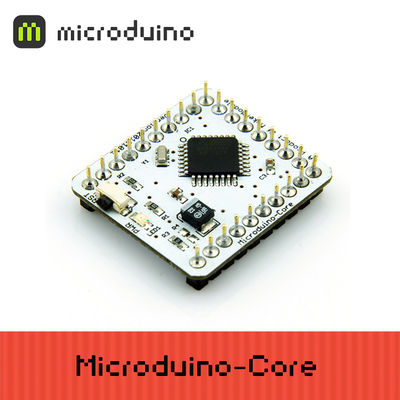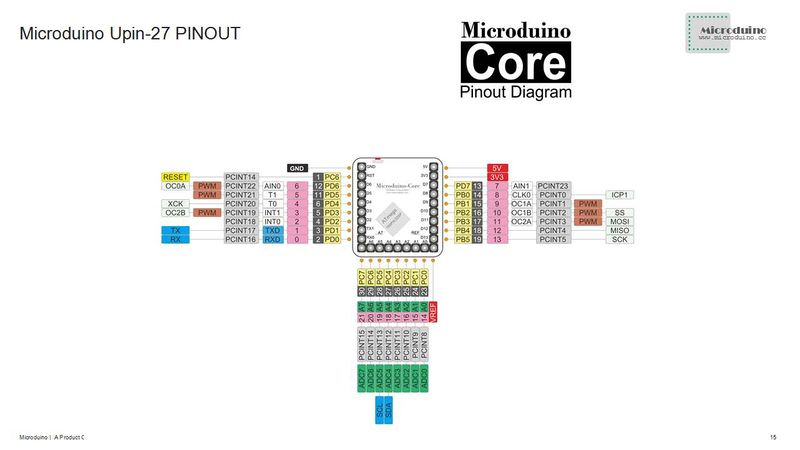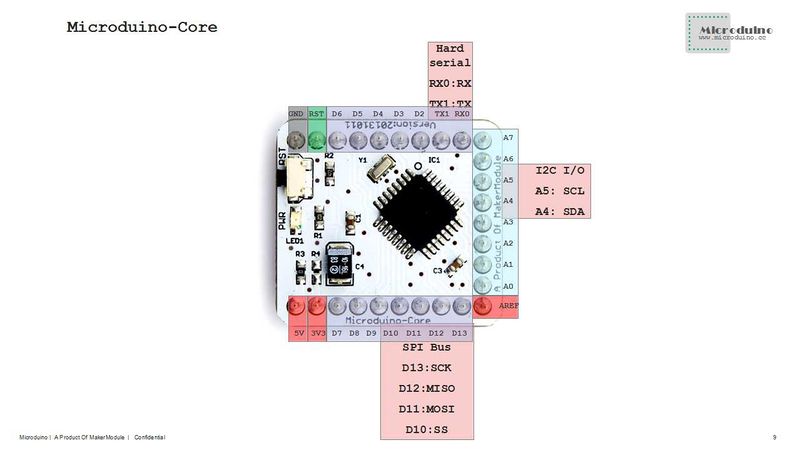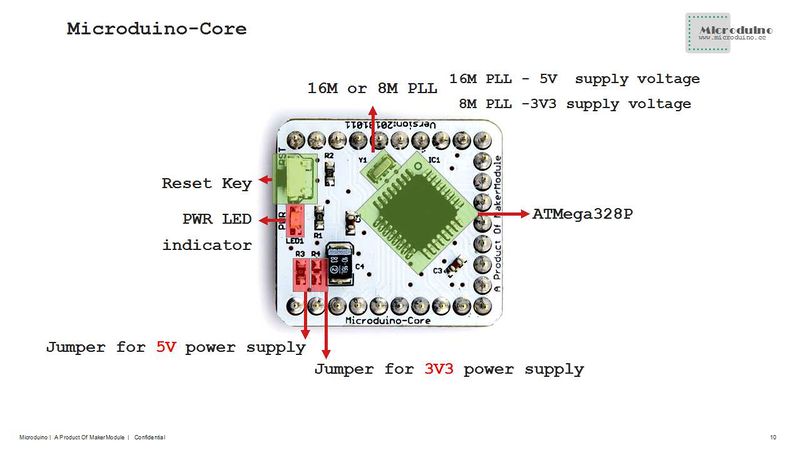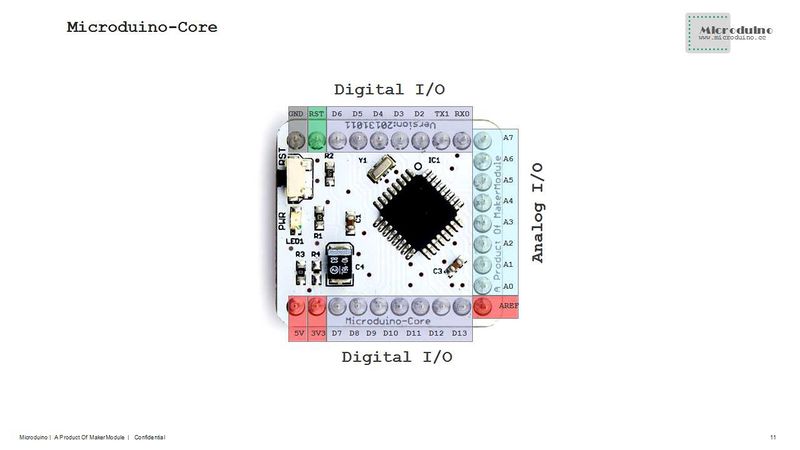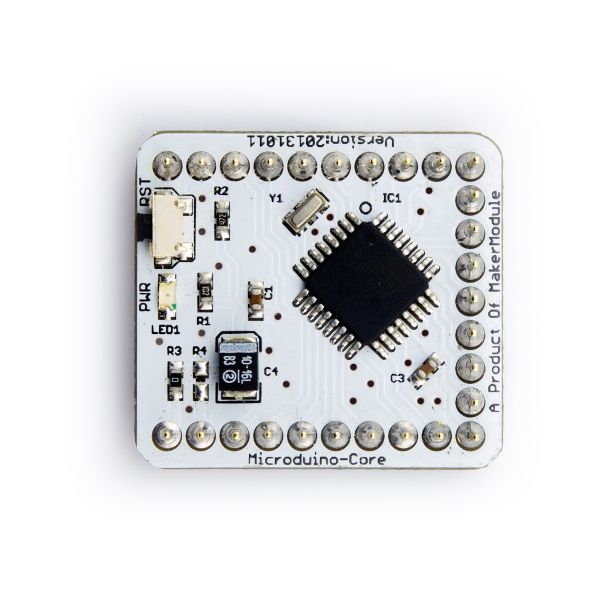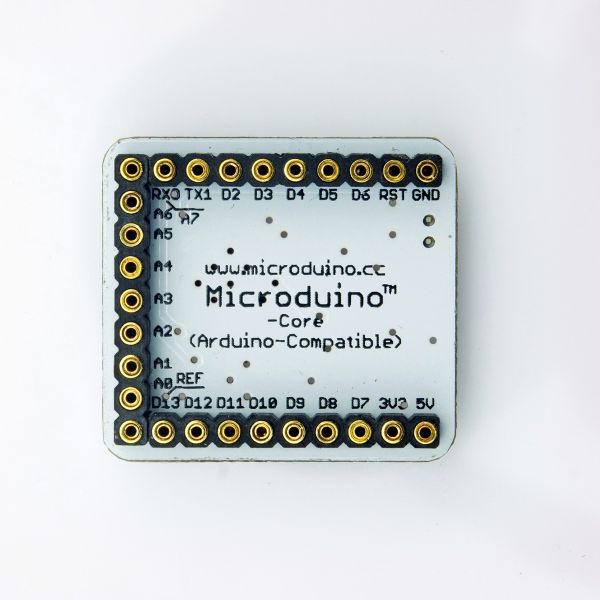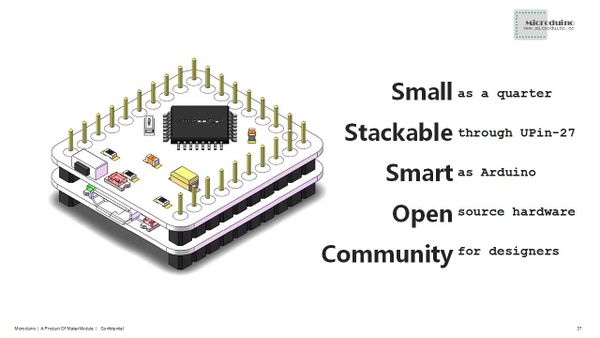|
마이크로두이노 코어모듈는 마이크로두이노 시리즈 코어 모듈중에 하나이다. 마이크로두이노 코어모듈는 아두이노 우노(UNO) 보드와 호환되는 오픈 소스 하드웨어이다. Atmel사의 ATmega328P/ATmega168PA 시리즈를 기반으로 한 8비트 마이크로컨트롤러 개발보드이다.
아두이노 우노보드와 비교해 보면, 마이크로두이노 코어모듈'의 특징은 아래와 같다.
- 마이크로두이노는 'U'자 모양의 27핀 인터페이스를 사용한다(UPin-27). 모든 마이크로두이노 코어 모듈, 확장 모듈, 확장 보드는 동일한 인터페이스를 사용하기 때문에 간단하게 연결해서 사용할 수 있다.
- 작은 사이즈와 일정한 인터페이스를 가지고 있으므로, 마이크로두이노는 시제품의 가격과 사이즈를 획기적으로 줄인다. 아두이노 호환보드이므로 사용자의 경험을 유용성과 사용성을 확대한다.
마이크로두이노는 아두이노와 동일한 개발환경을 사용하고 있고, 아두이노 IDE, 프로세싱을 이용하여 아이디어를 현실화하고 시제품을 개발하고 소량생산 할 수 있다.
마이크로두이노는 optiboot 부트로더를 사용하고 있으므로 아두이노 디폴트 엔진보다 작은 메모리를 사용하여 프로그램 업로딩을 최적화했다.
현재, 마이크로두이노 코어모듈은 4개 다른 구성을 가지고 있다.
| Type
|
Flash
|
SRAM
|
EEPROM
|
Frequency
|
Supply
|
| Atmega328P@16M,5V
|
32K
|
2K
|
1K
|
16M
|
5.0V
|
| ATmega328P@8M,3V3
|
32K
|
2K
|
1K
|
8M
|
3.3V
|
| ATmega168PA@16M,5V
|
16K
|
1K
|
512
|
16M
|
5.0V
|
| ATmega168PA@8M,3V3
|
16K
|
1K
|
512
|
8M
|
3.3V
|
주파수와 공급전원의 설정:
- 동작주파수와 공급전원이 연계되어 있는데, 8MHz 동작 모듈은 3.3V를 공급받고, 16MHz 동작 모듈은 5.0V를 공급받는다.
- 16MHz/5.0V 마이크로두이노 코어모듈은 데스크탑 장비나 디자인에 이용하고, 8MHz/3.3V 마이크로두이노 코어모듈은 저전력 배터리 전원공급이 가능한 모바일 디바이스를 설계하는데 사용할 것을 권장한다.
|
마이크로두이노 코어/코어 플러스 비교
- 마이크로두이노는 마이크로두이노 코어 플러스모듈이 있는데 SRAM/EEPROM/플레쉬의 용량이 더 크고 더 많은 I/O 포트를 제공하기 위한 목적이다.
- 마이크로두이노 코어와 마이크로두이노 코어 플러스모듈 둘 다 UPin-27 인터페이스를 사용하다. UPin-27 인터페이스는 마이크로두이노 시리즈의 기본 인터페이스이다. 두 모듈에서 다른 것은 사용한 MCU인데 코어모듈은 아두이노 우노와 동일한 ATmega328P/ATmega168PA을 사용했고, 코어 플러스 모듈은 아두이노 Mega2560과 비슷한 성능을 가지고 있다.
| Microduino
|
Chip
|
Flash
|
SRAM
|
EEPROM
|
Digital I/O
|
Analog I/O
|
PWM
|
Hardware Serial
|
| Core
|
Atmega168PA
|
16K
|
1K
|
512
|
23
|
8
|
6
|
1
|
| ATmega328P
|
32K
|
2K
|
1K
|
23
|
8
|
6
|
1
|
| Core+
|
Atmega644PA
|
64K
|
4K
|
2K
|
32
|
8
|
6
|
2
|
| ATmega1284P
|
128K
|
16K
|
4K
|
32
|
8
|
6
|
2
|
- According above table, Core and Core+ are different in Flash, EEPROM and SRAM size, also, they supply different size of digital I/O and hardware serial ports, and there are 10 more digital I/O and 1 more hardware serial ports in Core+. Designers can select specific module regarding different application requirements on function, performance and power.
- Both Core and Core+ use UPin-27 interface, Microduino program can be smoothly ported between them.
|
Features
- Small, Stack, Strong
- Open source hardware, using the same development environment as Arduino IDE
- Microduino-Core can be burned with ISP, same as Arduino, easy "bootloader"
- Using the U-Shape 27-pin interface (UPin-27), the standard interface of Microduino, all
Microduino modules and sensors can be easily stacked and extended through it
- Delivered ready to plug in.
- 2.54mm (0.1 inch) pin pitch, compatible to bread board and hole board
|
Specifications
- Microcontroller: ATmega328P/ATmega168PA
- Operating Voltage: 5V/3.3V
- Digital I/O Pins: 14 (of which 6 provide PWM output with D3,D5,D6,D9,D10 and D11)
- Analog Input Pins: 8 (2 more comparing to Arduino Uno)
- DC Current per I/O Pin: 40 mA
- DC Current: 50 mA
- Serial: 0 (RX) and 1 (TX). Used to receive (RX) and transmit (TX) TTL serial data.
- External Interrupts: 2 and 3. These pins can be configured to trigger an interrupt on a low value, a rising or falling edge, or a change in value. See the attachInterrupt() function for details.
- PWM: 3, 5, 6, 9, 10, and 11. Provide 8-bit PWM output with the analogWrite() function.
- SPI: 10 (SS), 11 (MOSI), 12 (MISO), 13 (SCK). These pins support SPI communication using the SPI
library.
- TWI: A4 or SDA pin and A5 or SCL pin. Support TWI communication using the Wire library.
- AREF. Reference voltage for the analog inputs. Used with analogReference().
- Flash Memory 32 KB (ATmega328P) of which 0.5 KB used by bootloader
- SRAM 2 KB (ATmega328P)
- EEPROM 1 KB (ATmega328P)
- Clock Speed 16MHz(5V) / 8Mhz(3.3V)
- Currently, there are 4 different configurations for Microduino-Core modules:
| Type
|
Flash
|
SRAM
|
EEPROM
|
Frequecy
|
Supply
|
| Atmega328P@16M,5V
|
32K
|
2K
|
1K
|
16M
|
5.0V
|
| ATmega328P@8M,3V3
|
32K
|
2K
|
1K
|
8M
|
3.3V
|
| ATmega168PA@16M,5V
|
16K
|
1K
|
512
|
16M
|
5.0V
|
| ATmega168PA@8M,3V3
|
16K
|
1K
|
512
|
8M
|
3.3V
|
|
Documents
|
Development
- Microduino Arduino IDE Configuration
- 1. Install Arduino IDE: Microduino use the same IDE as Arduino, please download Arduino IDE from 【Arduino IDE official】 and install it in your disk. (if you already have it, just skip this step). Please check Arduino IDE details from 【Reference】 and 【Workshop】.
- 2. Patch Microduino package: Please download Microduino package for Arduino IDE from 【download】, and unzip is to {Your Arduino Install Driectory}/hardware directory.
- Microduino Arduino IDE Reference workshop: 【Arduino IDE Microduino Configuration】.
- 3. Programming: To upload program to Microduino-Core/Core+ through Arduino IDE, designers are recommended to use Microduino-FT232R module.
- 4. Enjoy your Microduino journey!
- Burn Microduino BootLoader
- Bootloader burning is necessary if designers want to update Microduino-Core/Core+ firmware by themselves, designers can leaverage Arduino Uno or another burned Microduino-Core/Core+ to make a new one.
- Microduino bootloader workshop: 【Burn Bootloader to Microduino-Core/Core+ with an Arduino】.
- Bootloader is specified for different Microduino-Core/Core+ configurations, correct one must be selected during burning.
- Initial bootloader is designed for ATmegaX8 series optiboot, which occupies only 512 bytes flash.
- How to download program to Microduino through Arduino:Download program to Microduino through Arduino
|
Applications
- room-Microduino
- obdii-Microduino
- pilot-Microduino
- green-Microduino
- music-Microduino
|
FQA
- How to use the Microduino?
- Install Arduino IDE
- Download Arduino IDE Microduino hardware support package:【Media:Microduino-hardware.zip】
- Write the code in Arduino IDE,recommend use release 1.0 or upper
- Connect the hardware,core/core+ and USBTTL module, select the correct board type and download the program
- If download failed, please check the hardware connection firstly, and then reset the board, try again
- If still failure, you can search the failure information in internet, maybe need burn the bootloader. How to burn the bootloader, please refer to following link:【Burn Bootloader to Microduino-Core/Core+ with an Arduino】
- Do you have 3.3V version board?
- Does Core has PWM pin?
- Core supports six PWM output, that is I/O port 3,5,6,9,10 and 11. Core+ supports six PWM output, that is 7,8,9,10,22 and 23
Buy
|
History
- 2012/12/16: Published Microduino-Core patch for Arduino IDE
- 2012/11/18: Optimized the first formal release, finalized Miroduino-Core configuration
- 2012/11/06: Beta version.
|
Pictures
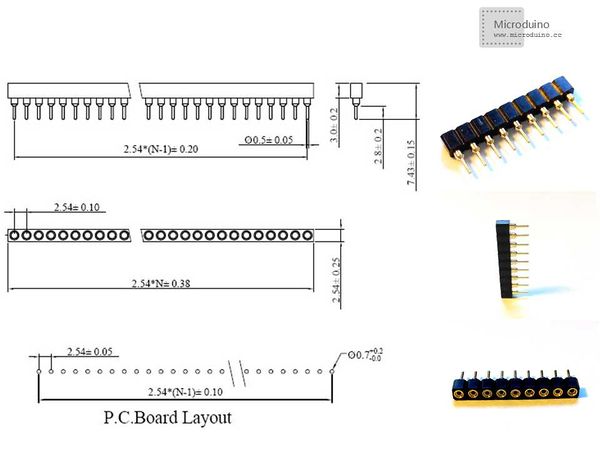 Microduino-core Upin27 model
|
